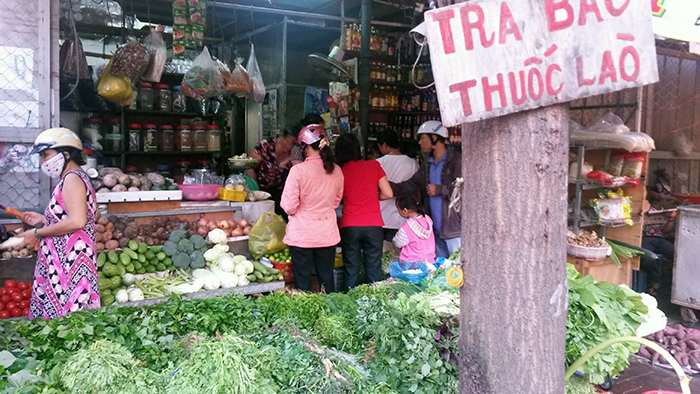The winter holidays have become a chance to test my culinary improvisational skills. Since I left home for college, my parents stopped celebrating Thanksgiving and Christmas—it is not a tradition they grew up with after all. I have learned to participate in the season’s festivities by making things up myself, and these bastardized dishes help me make sense of my own ambiguous and evolving cultural orientation.
This year, I am having a particularly nomadic autumn and winter. Thanksgiving brought me to Vietnam, where my friend Selina is teaching English. The first time we spent Thanksgiving together, we were part of a dozen or so “orphaned”—as our friend likes to say—freshmen and sophomores staying on our college campus for the holiday, and we successfully utilized the kitchens in two student houses to produce a complete feast. Now, after seven years and many more Friendsgivings, we had another chance to develop our “tradition.”

In tropical Vietnam, the markets and grocery stores abounded with dragon fruit, guavas, milk fruit, sugar apples, and various sorts of mangos. I was thrilled to finally not feel guilty about eating mangos that traveled overseas. Lacking a pie pan, I decided to make a couple galettes (like a freeform pie) with sliced mangos, dragon fruit, and cashews. Other dishes on our improvised menu included a tropical variation of mashed potatoes with garlic, scallions, and sesame oil. We even included lo mein.
“My family hardly celebrated Thanksgiving,” said another friend who grew up in Pennsylvania and now lives in Vietnam. “We always just made lo mein and ate crabs and lots of seafood.”
This holiday season, as I stretch my imagination for other non-traditional food ideas, I ask myself the same question I always do. As a cultural transplant, whose compass for home has already reoriented several times, how do I rightfully claim any authentic piece of food tradition? The question intensifies now, as—paradoxically—I find myself in Taipei, a hometown that has long ceased to feel like home. For me, there is really no constant when it comes to holiday food. The only constant—year after year—is the longing and homesickness, no matter where I am. My antidote is to create and appropriate something, like this co-opted galette, that hints at a taste that is at once familiar and adventurous.
The recipe below is meant to be adapted to use local fruits and nuts from wherever the wandering baker may be.
Mango Cashew Galette
Makes two
As Asian homes are not typically stocked with baking supplies, the directions below use basic tools. It is possible to substitute a rolling pin with a beer bottle or a tall, skinny glass and to make your own baking tray out of tinfoil—which I did!
Make the crust
2 1/2 cups flour
1 tsp salt
1 tbsp sugar
1 cup unsalted butter, cut into small cubes and frozen for about 30 minutes before use
1/4 to 1/2 cup ice water
Mix flour, salt, and sugar in a large bowl with a fork. Cut the cubed butter into the flour mixture. You can do this in a food processor, with a pastry blender, or with a fork (possibly together with a knife). Stop when the mixture still looks coarse and uneven. Pour in 1/4 cup of ice water. Mix the dough and see if it sticks together when squeezed. Gradually add more water if necessary, one tablespoon at a time. Divide the dough into two halves and shape them into two discs. Wrap them in plastic wrap (I used two plastic bags since I didn’t have plastic wrap on hand) and freeze the dough for at least one hour before use.
Make the galette
3 medium-sized mangos, sliced
1 dragon fruit, sliced
1/2 cup unsalted cashews, crushed or cut into small bits
6 tablespoons sugar
4 tablespoons flour
Milk for brushing
Whipped coconut cream (optional)
Mix crushed cashews, sugar, and flour in a small bowl. Preheat oven to 400 degrees Fahrenheit (204 degrees Celsius). Roll out both pie doughs. Spread the cashew flour out evenly over them, leaving a two-inch border. Arrange the sliced fruit over the cashew flour. Fold up edges of pie crust to partially cover the filling. Brush the pie dough with milk. Bake for about 50 minutes, or until the crust is golden and the mangos and dragon fruit look slightly brown on the edges. Cool slightly before serving. Serve with whipped coconut cream, or yogurt, or coconut rice pudding.
Joan Hua is a former staff member at the Center for Folklife and Cultural Heritage. She is currently sampling food in Vietnam and Taiwan after volunteering on organic farms in Germany.


